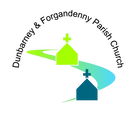|
Forgandenny Church lies about two miles from Forteviot, the ancient residence of the Pictish Kings. Thus it is not surprising to learn that there has been a church here since early times. Only a fragment of the ancient work is left as the building has been greatly altered at various times. On the inside it measures 70ft 7ins long by 21 ft 7 ins wide and accommodates 150 seats. The east wall is in the main Norman masonry. It has a splayed base which returns at each corner but most of this is hidden by rising ground toward the west.
|
|
The present church of Dunbarney was erected in 1787 to accommodate up to 650 persons with a pulpit in the middle of the south wall. The capacity has been reduced considerably by alterations which have removed two of the three galleries and introduced a vestibule. In 1923 the interior of the church was reconstructed and furnished by Laurence Pullar of Dunbarney and his wife, in whose memory a stained glass window was erected by the congregation. That reconstruction removed the east gallery and located the pulpit and communion table at the east end so re-orientating the seating. The pipe organ, built by John Miller, Dundee, was installed in 1929. The North Gallery was converted into a vestry during the building of the adjoining church hall in 2000.
|
